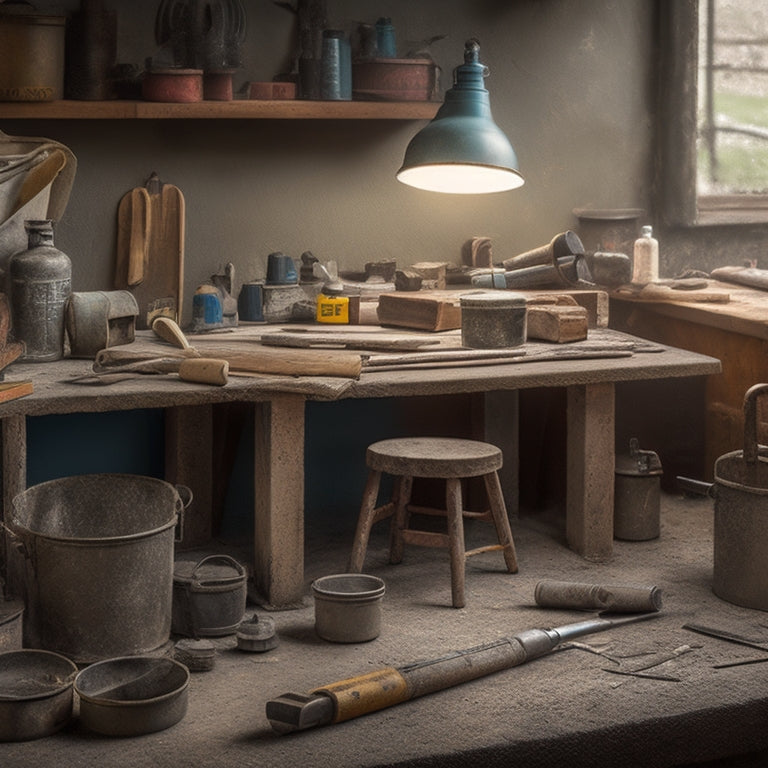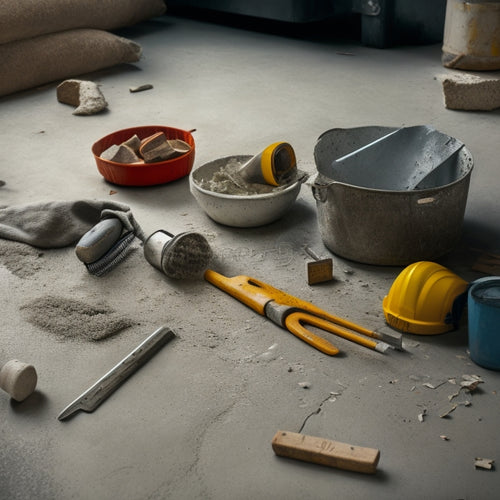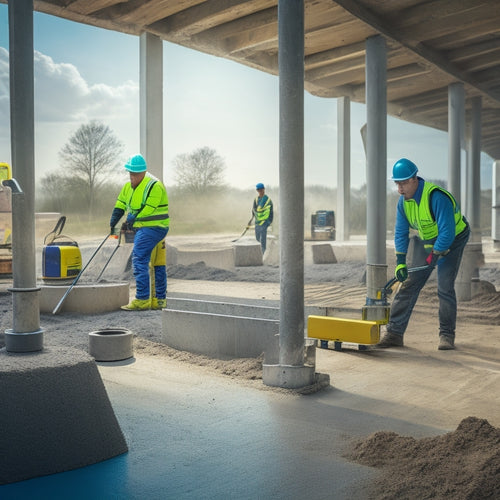
Top Tools for Filling Concrete Cracks at Home
Share
To fill concrete cracks at home, you'll need a range of specialized tools. Start by inspecting cracks with magnifying glasses, crack detection sprays, and surface analysis kits to determine severity, location, and cause of damage. Next, use measuring and marking devices like tape measures and chalk lines to accurately assess crack dimensions. Cleaning and preparation tools, such as wire brushes and pressure washers, guarantee a clean surface for repair. Epoxy injection equipment, polyurethane foam applicators, and sealant and caulk guns are essential for filling cracks with the right materials. With the right tools, you'll be well on your way to a successful repair – and there's more to learn about each of these tools to guarantee a job well done.
Key Takeaways
• Essential inspection tools like magnifying glasses, crack detection sprays, and surface analysis kits help identify crack severity, location, and cause.
• Measuring and marking devices, including tape measures and chalk lines, ensure accurate repair material application and minimize measurement errors.
• Cleaning and preparation tools, such as wire brushes, cleaning solutions, and pressure washers, remove debris and enhance bonding strength.
• Epoxy injection equipment, polyurethane foam applicators, and sealant/caulk guns are necessary for precise control over flow and pressure during repair.
• Proper techniques, including cleaning, layering, and smoothing, ensure a professional finish and long-lasting repairs when filling concrete cracks at home.
Essential Crack Inspection Tools
When evaluating concrete cracks, you'll need to conduct a thorough inspection to identify the severity, location, and cause of the damage. That's where essential crack inspection tools come into play. These tools help you detect even the smallest cracks and analyze the surface to determine the extent of the damage.
For effective crack detection, you'll need specialized tools such as magnifying glasses, crack detection sprays, and surface analysis kits.
Magnifying glasses allow you to zoom in on the crack, giving you a closer look at its width, depth, and pattern.
Crack detection sprays, on the other hand, help you identify cracks that may not be visible to the naked eye.
Surface analysis kits provide you with a detailed understanding of the concrete's surface, including its texture, porosity, and moisture levels.
Measuring and Marking Devices
Now that you've identified the cracks, you'll need to accurately measure their width, depth, and length to determine the best repair approach. This makes measuring and marking devices an essential part of your toolkit.
A reliable tape measure is a must-have for this task. It'll allow you to take precise measurements, ensuring you're using the right amount of repair material and minimizing waste. When choosing a tape measure, opt for one with clear markings and a sturdy design that can withstand rough handling.
In addition to a tape measure, a chalk line is another valuable tool for marking cracks. This simple yet effective device helps you create a clear, visible line along the crack, making it easier to apply repair materials accurately. By using a chalk line, you'll reduce the risk of applying material outside the crack, resulting in a neater and more professional-looking finish.
With these measuring and marking devices in your toolkit, you'll be well-equipped to tackle even the most complex concrete crack repairs with confidence.
Cleaning and Preparation Tools
You'll need to remove dirt, debris, and old repair materials from the crack before applying new materials, making effective cleaning and preparation tools essential to a successful repair.
For thorough cleaning, you'll want to invest in a wire brush or scrub brush to remove loose particles and dirt. Next, use a cleaning solution specifically designed for concrete to remove grease, oil, or other substances that may be hindering the repair. A pressure washer can also be used to blast away stubborn debris, but be cautious not to damage the surrounding concrete.
After cleaning, it's vital to prepare the surface for the new material. A surface preparation tool, such as a grinder or sandpaper, will help roughen the concrete and create a strong bond between the old and new material.
This step is critical, as a weak bond can lead to further cracking or failure. By using the right cleaning and preparation tools, you'll be able to create a strong, long-lasting repair that will withstand the test of time.
Epoxy Injection Equipment
When it comes to epoxy injection equipment, you'll need to select the right type of epoxy resin for your specific crack-filling project.
You'll also need to decide on the injection technique that best suits the crack's location, size, and orientation.
Types of Epoxy Resin
By selecting the appropriate type of epoxy resin for your concrete crack repair, you can guarantee a strong and durable bond that withstands various environmental and structural stresses.
There are several epoxy resin types to choose from, each with its unique characteristics and benefits. For instance, low-viscosity epoxy resins are ideal for hairline cracks, while high-viscosity resins are better suited for larger cracks.
You'll also need to take into account the epoxy curing methods, which can be either fast-cure, slow-cure, or hybrid. Fast-cure epoxies typically set within 5-10 minutes, making them perfect for time-sensitive projects. Slow-cure epoxies, on the other hand, take longer to set but offer more flexibility and working time. Hybrid epoxies combine the benefits of both, offering a balance between speed and flexibility.
When choosing an epoxy resin, contemplate factors such as temperature, humidity, and the type of concrete you're working with.
Injection Techniques Used
Epoxy injection equipment plays an important role in the crack repair process, as it enables precise control over the flow and pressure of the epoxy resin into the concrete crack.
When you're working with epoxy injection equipment, you'll have the ability to adjust the pressure and flow rate to suit the specific requirements of the crack filling method you're using. This level of control is vital, as it allows you to guarantee that the injection materials flow smoothly and evenly into the crack, filling it completely and preventing further damage.
As you work with epoxy injection equipment, you'll find that it's designed to accommodate a range of injection materials, from low-viscosity resins to thicker, more gel-like formulas.
This versatility is significant, as different cracks require different types of epoxy resin to achieve ideal results. By choosing the right epoxy injection equipment for your specific project, you'll be able to achieve professional-level results, even if you're working on a DIY basis.
With the right tools and materials, you'll be able to tackle even the most challenging crack filling projects with confidence.
Polyurethane Foam Applicators
You'll find polyurethane foam applicators in various forms, including handheld guns, dispensing tools, and injection systems, each designed to deliver precise amounts of foam into concrete cracks.
When choosing the right applicator, consider the size and complexity of the crack, as well as the polyurethane foam benefits you're looking for. For instance, handheld guns are ideal for small, shallow cracks, while dispensing tools are better suited for larger, more intricate ones.
To get the most out of your polyurethane foam applicator, it's crucial to master proper foam application techniques. This includes ensuring the surface is clean and dry, applying the foam in a consistent, even manner, and allowing it to fully expand and cure.
By following these best practices, you'll achieve a strong, durable bond that effectively seals the crack and prevents further damage.
With the right applicator and technique, you'll be able to harness the full potential of polyurethane foam, enjoying benefits like flexibility, adhesion, and resistance to water and chemicals.
Sealant and Caulk Guns
Sealant and caulk guns provide a versatile solution for filling concrete cracks, offering a range of benefits that make them a popular choice among professionals and DIYers alike.
With the right sealant type, you can guarantee a durable and long-lasting repair. From acrylic and silicone to polyurethane and epoxy-based sealants, each type has its unique characteristics, and selecting the right one depends on the crack's width, depth, and location.
When working with sealant and caulk guns, proper maintenance is essential to guarantee peak performance. You'll want to regularly clean the gun's nozzle and barrel to prevent clogs and dried sealant buildup.
Additionally, lubricate the gun's piston and seals to guarantee smooth operation. By doing so, you'll extend the lifespan of your caulk gun and avoid costly repairs.
As you work on filling concrete cracks, remember to follow the manufacturer's instructions for the specific sealant type and caulk gun you're using.
With the right tools and techniques, you'll achieve professional-looking results that will last for years to come. By mastering the use of sealant and caulk guns, you'll join the ranks of confident DIYers who can tackle even the most challenging concrete repair projects.
Frequently Asked Questions
Can I Use a Hair Dryer to Speed up the Drying Process?
When you're wondering if you can use a hair dryer to speed up the drying process, consider the hair dryer's efficacy in this situation.
While it may seem like a good idea, the drying time factors are essential. A hair dryer can actually hinder the process by creating hot spots, causing the filler to dry unevenly.
Instead, opt for a controlled environment with moderate temperatures and humidity to guarantee a smooth, even finish.
How Long Does It Take for Epoxy to Fully Cure?
When working with epoxy, you'll want to know how long it takes to fully cure.
The epoxy curing time depends on factors like temperature and mix ratio. Generally, it takes 24 hours for epoxy to reach 90% cure at room temperature (70-75°F).
However, epoxy temperature effects play a significant role - higher temps can speed up the process, while lower temps slow it down.
You'll reach 100% cure in 3-7 days, depending on the specific product and environmental conditions.
Can I Fill Cracks in the Winter When It's Cold Outside?
As you bundle up against the winter chill, you wonder if it's wise to tackle that cracked concrete.
Can you fill those cracks when the mercury dips? The short answer is yes, but be prepared for cold weather challenges.
Winter crack repair requires extra care, as epoxy and other fillers may take longer to cure or even freeze before they set.
You'll need to guarantee the area is dry, protected from wind, and ideally, above 40°F (4°C) for best results.
Are There Any Safety Precautions I Should Take When Working With Epoxy?
When working with epoxy, you'll want to prioritize safety.
Start by wearing protective gear like gloves, safety glasses, and a mask to prevent skin and eye irritation.
Guarantee good ventilation to avoid inhaling fumes.
Follow epoxy handling tips, such as mixing in a well-ventilated area and using a clean, dry surface.
Additionally, keep a fire extinguisher nearby and avoid smoking or open flames.
Can I Paint Over the Filled Cracks to Match the Surrounding Surface?
When you're ready to conceal the filled crack, you'll want to make certain the repair blends seamlessly with the surrounding surface.
You can paint over the filled cracks, but it's essential to take into account paint compatibility.
Research the epoxy's compatibility with your chosen paint to avoid peeling or flaking.
Proper crack repair techniques dictate a strong bond between the epoxy and paint, so take your time to get it right.
With the right approach, your repair will be virtually invisible.
Conclusion
You've successfully navigated the world of concrete crack repair, and now you're equipped with the top tools to tackle those pesky fissures like a pro.
With your new arsenal, you'll be filling cracks with ease, breathing new life into your concrete surfaces.
Remember, a well-maintained exterior isn't only aesthetically pleasing but also a safeguard against further damage and costly repairs down the line.
Related Posts
-

Top 10 Concrete Repair Tools for Small Fixes
You'll need the right tools to tackle small concrete repairs efficiently and effectively. When it comes to small fixe...
-

Top Tools for Mixing Concrete at Home
When mixing concrete at home, you'll need a range of tools to guarantee a successful operation. Start with essential ...
-

What Tools Ensure Precise Concrete Leveling Results
You need a range of specialized tools to achieve precise concrete leveling results. Laser leveling instruments provid...


